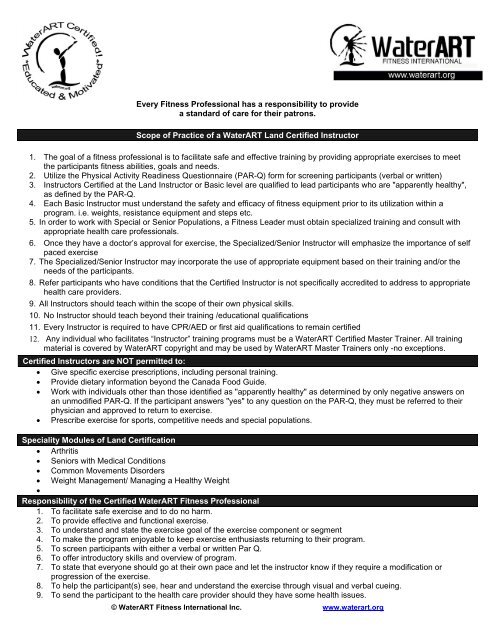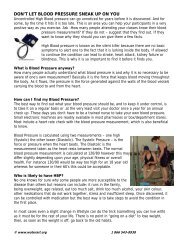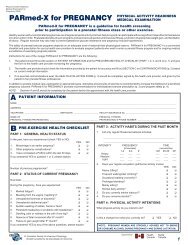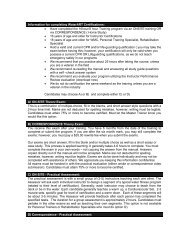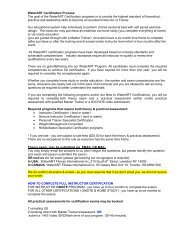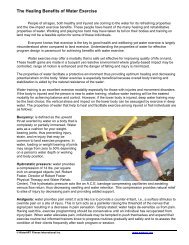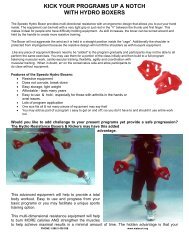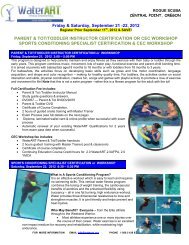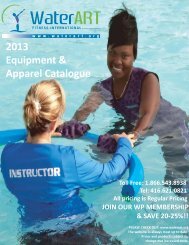WaterART Fitness International Guidelines for Land Fitness ...
WaterART Fitness International Guidelines for Land Fitness ...
WaterART Fitness International Guidelines for Land Fitness ...
You also want an ePaper? Increase the reach of your titles
YUMPU automatically turns print PDFs into web optimized ePapers that Google loves.
Every <strong>Fitness</strong> Professional has a responsibility to provide<br />
a standard of care <strong>for</strong> their patrons.<br />
Scope of Practice of a <strong>WaterART</strong> <strong>Land</strong> Certified Instructor<br />
1. The goal of a fitness professional is to facilitate safe and effective training by providing appropriate exercises to meet<br />
the participants fitness abilities, goals and needs.<br />
2. Utilize the Physical Activity Readiness Questionnaire (PAR-Q) <strong>for</strong>m <strong>for</strong> screening participants (verbal or written)<br />
3. Instructors Certified at the <strong>Land</strong> Instructor or Basic level are qualified to lead participants who are "apparently healthy",<br />
as defined by the PAR-Q.<br />
4. Each Basic Instructor must understand the safety and efficacy of fitness equipment prior to its utilization within a<br />
program. i.e. weights, resistance equipment and steps etc.<br />
5. In order to work with Special or Senior Populations, a <strong>Fitness</strong> Leader must obtain specialized training and consult with<br />
appropriate health care professionals.<br />
6. Once they have a doctor’s approval <strong>for</strong> exercise, the Specialized/Senior Instructor will emphasize the importance of self<br />
paced exercise<br />
7. The Specialized/Senior Instructor may incorporate the use of appropriate equipment based on their training and/or the<br />
needs of the participants.<br />
8. Refer participants who have conditions that the Certified Instructor is not specifically accredited to address to appropriate<br />
health care providers.<br />
9. All Instructors should teach within the scope of their own physical skills.<br />
10. No Instructor should teach beyond their training /educational qualifications<br />
11. Every Instructor is required to have CPR/AED or first aid qualifications to remain certified<br />
12. Any individual who facilitates “Instructor” training programs must be a <strong>WaterART</strong> Certified Master Trainer. All training<br />
material is covered by <strong>WaterART</strong> copyright and may be used by <strong>WaterART</strong> Master Trainers only -no exceptions.<br />
Certified Instructors are NOT permitted to:<br />
• Give specific exercise prescriptions, including personal training.<br />
• Provide dietary in<strong>for</strong>mation beyond the Canada Food Guide.<br />
• Work with individuals other than those identified as "apparently healthy" as determined by only negative answers on<br />
an unmodified PAR-Q. If the participant answers "yes" to any question on the PAR-Q, they must be referred to their<br />
physician and approved to return to exercise.<br />
• Prescribe exercise <strong>for</strong> sports, competitive needs and special populations.<br />
Speciality Modules of <strong>Land</strong> Certification<br />
• Arthritis<br />
• Seniors with Medical Conditions<br />
• Common Movements Disorders<br />
• Weight Management/ Managing a Healthy Weight<br />
•<br />
Responsibility of the Certified <strong>WaterART</strong> <strong>Fitness</strong> Professional<br />
1. To facilitate safe exercise and to do no harm.<br />
2. To provide effective and functional exercise.<br />
3. To understand and state the exercise goal of the exercise component or segment<br />
4. To make the program enjoyable to keep exercise enthusiasts returning to their program.<br />
5. To screen participants with either a verbal or written Par Q.<br />
6. To offer introductory skills and overview of program.<br />
7. To state that everyone should go at their own pace and let the instructor know if they require a modification or<br />
progression of the exercise.<br />
8. To help the participant(s) see, hear and understand the exercise through visual and verbal cueing.<br />
9. To send the participant to the health care provider should they have some health issues.<br />
© <strong>WaterART</strong> <strong>Fitness</strong> <strong>International</strong> Inc. www.waterart.org
10. To send the participant to another program (i.e. Speciality training) should the participant not have the skill level to<br />
work safely within the program?<br />
11. To modify the exercise at patrons request<br />
12. To progress the exercise at the patrons request<br />
Instructor Code of Conduct<br />
1. Wear professional clothing and footwear<br />
2. Teach monitor and regulate intensity.<br />
3. Provide an appropriate warm up and cool down <strong>for</strong> all classes<br />
4. Do not jump, bounce or per<strong>for</strong>m too many repetitions of an exercise to cause stress or repetitive stress injuries<br />
<strong>WaterART</strong> ‘s <strong>Guidelines</strong> <strong>for</strong> Exercise Technique<br />
All patrons/clients should be able to see, hear & understand the exercise instructions in terms of purpose, safety and<br />
technique. <strong>WaterART</strong> realizes the challenge of facilitating multi-skilled and fitness levelled programs. Facilities, conditions<br />
and variety of patrons may be anything but perfect.<br />
1. Instructors may should not teach beyond their scope of practice nor fitness level<br />
2. Should drink water and encourage participants to do the same throughout a program<br />
3. Should never <strong>for</strong>ce anyone to per<strong>for</strong>m an exercise<br />
4. Should never manually adjust a person<br />
5. Should terminate the program if any conditions become hazardous to the instructor’s or participants’ well being.<br />
6. Be aware of voice injury. Utilize visual cueing and a microphone when possible.<br />
7. Execute movements in good posture in <strong>for</strong>m as an instructor –be a good model.<br />
8. Cue a neutral spinal alignment with each class –show how to maintain a good posture .<br />
9. Work within your own body’s limits – teach <strong>for</strong> long term – and injury prevention.<br />
10. When cueing show movements visually and explain verbally<br />
11. Demonstrate the “start position” of the exercise when showing a movement pattern.<br />
12. Demonstrate the “end position” of the exercise when showing a movement pattern.<br />
13. Do not keep the arms/hands above the head/heart <strong>for</strong> more than a minute (due to pressor response and an increase<br />
in blood pressure )<br />
14. Do not twist or torque the knees.<br />
15. Cue movement to keep the hips, knees, and toes to remain in a parallel alignment with walking and squats<br />
16. For muscular strengthening per<strong>for</strong>m at least 1-2 sets of 8-10 repetitions with equipment if possible or till muscle<br />
fatigue.<br />
17. For muscular endurance per<strong>for</strong>m at least 1-2 sets of 8-10 repetitions without equipment <strong>for</strong> optimal benefits.<br />
18. For Cardiovascular endurance moderate to low intensity <strong>for</strong> 3-10 minutes, 3-5 times a week will yield positive benefits<br />
19. Cardiovascular training should utilize primarily rhythmical lower body movements with safe change of direction.<br />
20. Utilize active flexibility in the beginning of a program and more static stretching at the end of a program<br />
21. All components of fitness are valuable in a program. Incorporate a mixture of muscle strength, flexibility, agility,<br />
coordination, balance, posture and cardiovascular <strong>for</strong>mats as suitable <strong>for</strong> the program <strong>for</strong> optimal per<strong>for</strong>mance<br />
training.<br />
22. State the purpose of the exercise when training. All components are important yet unique to train.<br />
23. Clients should not exercise if the resting heart rate is above 100 bpm<br />
24. All instructors should provide a suitable cool down period to gradually bring the heart rate down.<br />
<strong>Guidelines</strong> <strong>for</strong> Exercise Safety<br />
• There should be no radiation of pain into the arm or fingers, especially with neck movements.<br />
• Typically, you will have to strengthen the external rotators, rhomboids, lower fibers of the trapezius, posterior deltoids,<br />
triceps, biceps, and latissimus dorsi.<br />
Stretch the pectorals, anterior deltoid and subscapularis.<br />
Protect your Patrons shoulders against Impingement<br />
When overhead movement becomes uncontrolled and/or overworked, the humeral head begins to hit up against the acromion<br />
process. Impingement syndrome usually occurs between 70 and 120 degrees of abduction of the arm – this is also referred<br />
to as the "painful arc" when the humerus is internally rotated in the shoulder joint. This is a common occurrence if the arm is<br />
taken above 90 degrees with the hands facing down (such as when holding weights). Cue safe ROM to prevent rounding of<br />
the shoulders and impingement of the shoulder joint. Impingement usually progresses to rotator cuff tear. Weak areas to be<br />
aware of are scapular musculature, muscles of the rotator cuff and chest, and pronators/supinators of the <strong>for</strong>earm and hand.<br />
© <strong>WaterART</strong> <strong>Fitness</strong> <strong>International</strong> Inc. www.waterart.org
<strong>Guidelines</strong> For Referral Back To Health Care Provider<br />
There are a multitude of reasons to discontinue exercise or training. A Certified Instructor should use a conservative approach<br />
and stay within their scope of practice.<br />
The following reasons should be noted & a Certified instructor should refer their patrons/clients back to a Health Care Provider<br />
and/or Medical Specialist when they see the following:<br />
• If abnormal breathing patterns occur or gasping <strong>for</strong> breath.<br />
• If physical condition does not improve.<br />
• Discoloration of lips (blue).<br />
• Tightness of chest<br />
• Feel worse in the water.<br />
• Increase in pain during and after exercise.<br />
• Any pain and discom<strong>for</strong>t, especially tingling or numbness in the neck, shoulders, chest, arms, legs.<br />
• Shortness of breath or a high HR or RPE.<br />
• Exhaustion during/after exercise.<br />
• Sickness.<br />
• If resting heart rate is above 90 bpm ( if without doctor onsite) or 100 bpm ( if doctor is onsite)<br />
• If participant reports or shows excessive fatigue, severe thirst, frequent urination, nausea, vomiting.<br />
• If participant reports or shows shortness of breath.<br />
• If participant experiences undue pain, pressure, aches, numbness, tingling.<br />
• If the participant becomes disoriented or confused.<br />
• Energy levels decrease.<br />
• Any tenderness, swelling or redness around a joint.<br />
Note: We recommend annual physical assessments with all patrons/clients. Should a health history change, it is<br />
the responsibility of the client to let the instructor know their limitations.<br />
Appendices<br />
Verbal PAR-Q <strong>Guidelines</strong><br />
* <strong>for</strong> programs that do not do thorough screening – this is a minimal requirement<br />
Intent of the PAR-Q<br />
The Physical Activity Readiness Questionnaire (PAR-Q) is an easy to use 2-page <strong>for</strong>m that is used to see if participants<br />
should check with their doctor be<strong>for</strong>e becoming much more physically active.<br />
Challenge of administering the written PAR-Q <strong>for</strong>m:<br />
Group and aquatic fitness trainers, instructors or specialists that do not have the opportunity to administer the written PAR-Q<br />
with each participant or a complete health history and screening evaluations. This must be done prior to starting a program.<br />
This is especially applicable <strong>for</strong> participants will show up 5 minutes late ( and are joining a group program.) At this point it is<br />
not feasible <strong>for</strong> the instructor to stop the class to administer the PAR-Q <strong>for</strong> the late participant. If the PAR-Q is filled out at the<br />
front desk be<strong>for</strong>e the participant enters the facility the challenge then becomes how to get that in<strong>for</strong>mation to the leader be<strong>for</strong>e<br />
the class starts.<br />
Rationale:<br />
The PAR-Q has two purposes:<br />
1) Build self awareness at the participant level and<br />
2) Help to in<strong>for</strong>m the leader of participant needs and concerns.<br />
By administering the verbal PAR-Q at the start of program the participant is made aware of any conditions in which they may<br />
want to discuss with their doctor and they have the opportunity to let their fitness instructor know of such conditions. In this<br />
situation the PAR-Q is in<strong>for</strong>ming both the participant and the leader.<br />
Group and aquatic instructors/trainers/specialists create a generalized program <strong>for</strong> the class in which modifications are<br />
presented so that the participants are able to adjust the level of the class on their own to suit their needs.<br />
© <strong>WaterART</strong> <strong>Fitness</strong> <strong>International</strong> Inc. www.waterart.org
Verbal PAR-Q Instructions<br />
STEP #1: The leader verbally asks the participants be<strong>for</strong>e every class “Is there anyone in the class who has not completed a<br />
written or verbal PAR-Q in the past 12 months?”<br />
STEP #2: If any participants answer “Yes” to the question in STEP #1 or if the leader observes a new participant in the class<br />
or if it is the start of a new session <strong>for</strong> a registered program; then the leader must verbally read the following exactly as written<br />
to the whole class (If all participants answer “No” to STEP #1 then the leader does not have to read the following):<br />
If you are between the ages of 15 and 69, the PAR-Q will tell you if you should check with your doctor be<strong>for</strong>e you start<br />
exercising. If you are over 69 years of age, and you are not used to being very active, check with your doctor be<strong>for</strong>e you start<br />
an exercise program.<br />
Common sense is your best guide when you answer these questions. Please listen to the questions carefully and answer<br />
each one honestly to yourself yes or no.<br />
Questions:<br />
1. Has your doctor ever said that you have a heart condition and that you should only do physical activity recommended<br />
by a doctor?<br />
2. Do you feel pain in your chest when you do physical activity?<br />
3. In the past month, have you had chest pain when you were not doing physical activity?<br />
4. Do you lose your balance because of dizziness or do you ever lose consciousness?<br />
5. Do you have a bone or joint problem (<strong>for</strong> example, back, knee or hip) that could be made worse by a change in your<br />
physical activity?<br />
6. Is your doctor currently prescribing drugs (<strong>for</strong> example, water pills) <strong>for</strong> your blood pressure or heart condition?<br />
7. Do you know of any other reason why you should not do physical activity?<br />
If you answered YES to one or more questions: Talk with your doctor by phone or in person be<strong>for</strong>e you start<br />
becoming much more physically active. Tell your doctor about the PAR-Q and which questions you answered YES.<br />
STEP #3: If a participant joins the class late which results in them not being present <strong>for</strong> the verbal PAR-Q the fitness leader<br />
must give the participant a copy of the BCRPA Participant PAR-Q In<strong>for</strong>mation sheet.<br />
Participant PAR-Q In<strong>for</strong>mation Sheet<br />
If you are between the ages of 15 and 69, the PAR-Q will tell you if you should check with your doctor be<strong>for</strong>e you start<br />
exercising. If you are over 69 years of age, and you are not used to being vary active, check with your doctor be<strong>for</strong>e you start<br />
an exercise program.<br />
Common sense is your best guide when you answer these questions. Please read to the questions carefully and answer each<br />
one honestly to yourself yes or no.<br />
Questions:<br />
1. Has your doctor ever said that you have a heart condition and that you should only do physical activity recommended<br />
by a doctor?<br />
2. do you feel pain in your chest when you do physical activity?<br />
3. In the past month, have you had chest pain when you were not doing physical activity?<br />
4. Do you lose your balance because of dizziness or do you ever lose consciousness?<br />
5. Do you have a bone or joint problem (<strong>for</strong> example, back, knee or hip) that could be made worse by a change in your<br />
physical activity?<br />
6. Is your doctor currently prescribing drugs (<strong>for</strong> example, water pills) <strong>for</strong> your blood pressure or heart condition?<br />
7. Do you know of any other reason why you should not do physical activity?<br />
If you answered YES to one or more questions: Talk with your doctor by phone or in person be<strong>for</strong>e you start<br />
becoming much more physically active. Tell your doctor about the PAR-Q and which questions you answered YES.<br />
© <strong>WaterART</strong> <strong>Fitness</strong> <strong>International</strong> Inc. www.waterart.org


